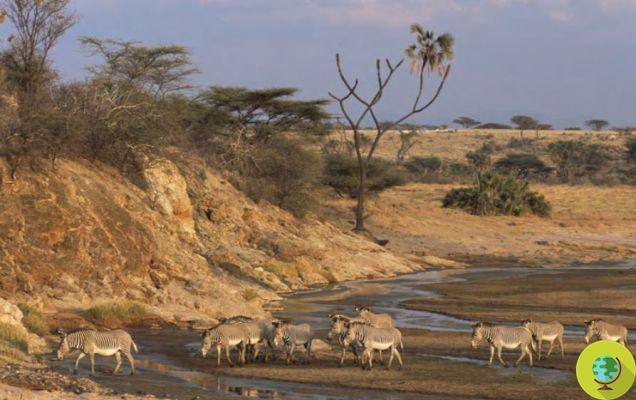Grevy's zebras are dying of hunger and risk extinction: to save them, we are forced to feed them, but in this way we risk domesticating them
He is about to end up run over, his mother saves himFeeding wildlife is generally not recommended, but in the case of Grevy's zebra it might be the only way to ensure the survival of this species.
The Grevy's zebra (Equus grevyi) also called the imperial zebra, is a mammal that lives in an area of Africa between Kenya, Ethiopia and Somalia.
These are huge and extraordinary zebras whose population is now reduced to 2000 adult specimens and risks becoming extinct in a short time.
The species is indeed threatened by hunting since the twentieth century and the specimens today are suffering dramatically from the lack of resources, mainly due to the extraordinary drought that has affected their ecosystem for ten years.
Since 2009, the regular waves of drought caused by the climate crisis have drained the waterways, made the land arid and dried the grass on which the zebras feed.

Grevy's Zebra Trust
In addition to the drought, the cattle grazing, more and more relevant as intensive farming grows.
For this reason, although it is normally a practice to be avoided, the Grevy's Zebra Trust has decided to providing food to the zebras, placing thousands of hay bales in the area every year from 2011 to today.
Circa 3.500 bales of hay they are bought every year from a nearby less arid province, transported by truck or motorbike and placed along the routes that the zebras travel on to go to the waterways.
It is a decision made for cope with the emergency, because feeding wild animals makes them dependent on humans, compromising their ability to forage for food.
La wildlife he should never get used to dealing with humans, as this type of interaction dangerously alters the behavior of animals.
When a wild species no longer fears humans, the specimens can approach homes and cultivated fields, with consequent risks for people and crops.
This is what we see happening here too, with wild boars increasingly venturing out of the woods in search of food, as hunters have given them food to make them tame and more easily catchable.
Unfortunately, when this happens, the answer is almost always to kill animals that have become dangerous for human safety and are guilty of damaging crops.
In the case of Grevy's zebras, providing them with food to feed on is the only way to keep them from starving.
To ward off the danger of animals getting used to it in the presence of humans, the food is placed without approaching the zebras and without having any contact with them, so that they cannot know where the hay comes from.
However, this is a short-term intervention, while the long-term goal is to find solutions to be able to bring together humans, livestock and wild animals, restoring environmental conditions that allow the existence of pastures for all animals.
This will mean cut down acacia trees which do not serve as food for the zebras e planting grass seeds useful for animals.
The situation demonstrates how our impact continually has devastating effects on nature, generating chain events to which we struggle to find solutions.
The only way to avoid similar problems recurring is learn to better manage the landscape and resources, so that humans and other animals can thrive together.
Read also:
- Why do zebras have stripes? Blame the insects?
- The polka dot zebra really exists! Her name is Tira and she was born in the Kenyan reserve of Masaai Mara


























